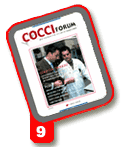Technically speaking: a better idea
Managing intestinal health without in-feed antibiotics - a practical approach
Dr. Delair Bolis, Schering-Plough Animal Health, PortugalDr. Luciano Gobbi, Schering-Plough Animal Health, Italy
Controlling intestinal disease without
drugs is a growing trend
among poultry companies
around the world due to public concern
about drug residues in food as
well as the high level of resistance to
some of the in-feed drugs that are still
available.
In North America and
Western Europe, for instance, more
than 10% of poultry production today is
achieved without in-feed anticoccidials. The goal is to produce meat without
feed additives while maintaining competitive
production costs.
On page 6 in this issue, Nutrition
Notebook focuses on dietary approaches
under the IDEA Program that help
ensure intestinal health in birds raised
without anticoccidials. The IDEA concept
has been successfully used in several
countries.
It was designed by
Schering-Plough Animal Health Corporation
to make the most of nutrition
and performance in coccidiosis-vaccinated
birds. It seeks to enhance immunity
development and reduce intestinal
challenges by coccidia and bacteria
without the use of drugs. Although
nutrition is key to IDEA, so are feeding
management and environmental considerations,
which are the focus of this
article.

Dr. Delair Bolis |

Dr. Luciano Gobbi |
I is for Impulse
Coccidiosis vaccination early
in life is vital to the success
of drug-free production. It
improves coccidiosis control
and provides performance comparable
to that achieved with in-feed
anticoccidials. It reduces concern
about drug residues in meat, increases
feed and slaughter flexibility and
revitalizes anticoccidial sensitivity. Feeding management
Newly hatched chickens need immediate
access to solid feed and water to
set the stage for good performance
later. Birds need to achieve maximum
duodenum villi development in the
first week and maximum jejunum and
ileum villi development during the
second week of life after hatching.
Chickens less than 10 to 12 days
old should have access to supplemental
feed dispensers or paper lanes
where crumbled feed is distributed
daily. This minimizes litter-picking,
which results in ingestion of excessive
bacteria, viruses and coccidial
oocysts. Premature removal of extra
feed sources must be gradual and
based on the general condition of
birds upon their arrival at the farm.
The "eye and hand" of the poultry
attendant can make the difference
between success and failure, since
careful consideration must be given
to issues such as when to remove
supplemental feeder pans, give birds
more space or move them to the full
house. Environmental managementTo grow well, brooders require the proper temperature, humidity, ventilation, lighting and litter management.
|
D Is for DigestabilityBetween 3 and 4 weeks of life, birds are challenged by bacteria and coccidia, but their immunity is still not completely developed. Under the IDEA concept, this is the time that producers need to focus on feeding and environmental management that improves digestibility. Feeding management
Gut mucosa at 3 and 4 weeks is subject
to lesions due to histamine and
in-feed biogenic amines or toxic
ingredients. Intestinal irritation can
open the door to second invaders,
mainly bacteria. The result can be
intestinal dysbacteriosis or intestinal
disturbance as well as subclinical
necrotic enteritis. Clostridial perfringens
types A and C play a major role,
but other bacteria can be involved. Environmental management
|
E Is for EconomyProducers who have used the management approaches outlined above should have chickens that reach 30 days of age with good intestinal health. Immunity is developed and it's now time to take advantage of the compensatory gain by moving on to a withdrawal diet sooner than usual. |
A Is for AdvanceThe "A" in IDEA represents the overall program goal of maximizing performance in birds that depend on good immunity for optimal gut function. It also reflects advances made in the areas of intestinal disease management and profitability. |
Source: CocciForum Issue No.9, Schering-Plough Animal Health.










